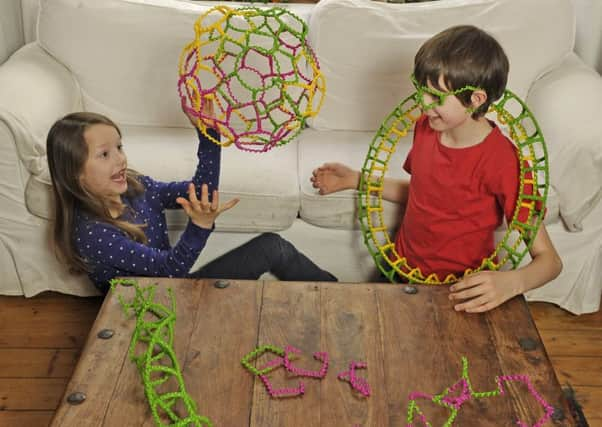Why bendy building toy clicks with children


Made from durable polyethylene and developed using state-of-the-art 3D printing technology, it’s bendy, virtually impossible to break and even recyclable.
Named Stems, it could be described as a 21st-century version of Lego.
Advertisement
Hide AdAdvertisement
Hide AdChildren can use the linkable pieces in a multitude of ways. Some build geometric structures while others create more organic forms, abstract decorative pieces or wearable items.
Early testers, both young and old, have produced everything from giant wheels and bouncy balls, to spectacles, a motorbike and fairy wings. There has even been a scaled-down version of the Kelpies sculpture.
Now audiences in the capital will have the chance to demonstrate their own creative skills when Stems is officially launched at a special event at Edinburgh International Science Festival, which kicks off next weekend.
Euan Lind, who lives in Edinburgh, trained as an artist and designer but also worked as a learning assistant in schools and nurseries.
His previous inventions include a contemporary light fitting for interiors specialist Habitat.
He was inspired to create the novel toy after a childhood spent experimenting with Lego, which sparked a lifelong fascination with geometry.
“I love working with children, and their openness to the world is great when you’re trying to think of something new,” he said.
“I guess Stems evolved from my interest in different ways of making structures, and making things generally.
Advertisement
Hide AdAdvertisement
Hide Ad“I was always fascinated by what you could do with origami-like processes and developable surfaces. You can think of geometry just as surfaces that are stretched in different ways. I eventually came up with this single-stem piece that is deformable, can stretch and contract, so you can make three-dimensional shapes out of it.”
The toy can be used by anyone from age five and upwards, though adults seem to like it too.
Lind is particularly enthusiastic about the creative freedom offered by his invention.
“Lego is incredibly innovative and I am a huge fan, but in some respects it is a product of the 1960s, when technology allowed people to make rectangular forms and quite rigid things,” he said.
“But now, because of 3D printing and rapid prototyping you’re able to iterate much faster and try forms that would have been impossible to produce 50 years ago.
“With Stems, people seem to love the process of joining the pieces. The way they snap together is absorbing in itself and often that’s what stimulates people to explore what they can do.”
Terence Finnegan, event developer and Mini Maker Faire co-ordinator for the festival, said: “Getting hands-on with science lies at the heart of what we do at Edinburgh International Science Festival and Euan Lind’s Stems, Bend Your Brain, are a great illustration of that.
“His invention is not only a great learning tool for children, inspiring them to wonder how and why it was made, but also shows that the sky is the limit for human creativity.”
Advertisement
Hide AdAdvertisement
Hide AdLind and his team will be on hand to offer creative encouragement and answer questions.
Other highlights of this year’s festival include: Moments in Time, celebrating Scottish scientific history, at the Mound Precinct; Play On, about how technology influences leisure time, at the National Museum of Scotland; Dr Stirlingshire’s Discovery, a theatrical production about a cryptozoologist, at Edinburgh Zoo; Low Impact Meal, which examines how to eat a more sustainable diet and includes a taster menu, at Summerhall; and Who Will Scam Us Next and How, with cyber security expert Prof Bill Buchanan, at the National Museum of Scotland.
Pop-up Science: Stems, Bend Your Brain is at the National Museum of Scotland from 6 to 10 April, 10am to 5pm